 Happy Diwali to all our families and friends!
Happy Diwali to all our families and friends!
One of the most significant festivals in Indian culture, Diwali, the festival of lights, sees millions attend firework displays, prayers and celebratory events across the world every autumn.
The festival is celebrated by Hindus, Sikhs and Jains for a variety of reasons, although the main theme which runs throughout is the triumph of light over darkness and good over evil.
To celebrate, houses are decorated with candles and colourful lights and huge firework displays are held while families feast and share gifts.
Click here for Diwali video by National Geographic
What is Diwali?
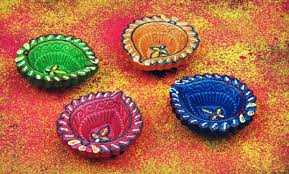 Diwali is the five-day festival of lights, celebrated by millions of Hindus, Sikhs and Jains across the world. The festival, which coincides with the Hindu New Year, celebrates new beginnings and the triumph of good over evil and light over darkness. The actual day of Diwali is traditionally celebrated on the festival’s third day, which this year falls on Wednesday 11th of November 2015. The festival usually falls between the middle of October and the middle of November, although this is decided upon by the Hindu lunar calendar.
Diwali is the five-day festival of lights, celebrated by millions of Hindus, Sikhs and Jains across the world. The festival, which coincides with the Hindu New Year, celebrates new beginnings and the triumph of good over evil and light over darkness. The actual day of Diwali is traditionally celebrated on the festival’s third day, which this year falls on Wednesday 11th of November 2015. The festival usually falls between the middle of October and the middle of November, although this is decided upon by the Hindu lunar calendar.
While each faith has its own reason to celebrate the festival, one of the most popular stories told is the legend of 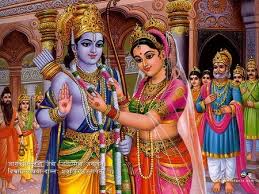 Lord Rama and his wife Sita returning to their kingdom in northern India from exile after defeating the demon king Ravanna in the 15th century BC.
Lord Rama and his wife Sita returning to their kingdom in northern India from exile after defeating the demon king Ravanna in the 15th century BC.
Click here to view video of the story of Rama and Sita
How is Diwali celebrated?
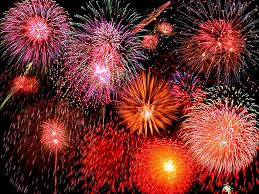 The festival is marked by large firework displays, to remember the celebrations which, according to the legend, took place upon Rama’s return as locals set off their own version of fireworks. Those celebrating the festival also light traditional earthen diyas (candles) and decorate their houses with colourful rangoli artworks- patterns created on the floor using coloured rice or powder. During Diwali, families and friends share sweets and gifts and there is also a strong belief in giving food and goods to those in need. It is also traditional for homes to be cleaned and new clothes to be worn at the time of the festival.
The festival is marked by large firework displays, to remember the celebrations which, according to the legend, took place upon Rama’s return as locals set off their own version of fireworks. Those celebrating the festival also light traditional earthen diyas (candles) and decorate their houses with colourful rangoli artworks- patterns created on the floor using coloured rice or powder. During Diwali, families and friends share sweets and gifts and there is also a strong belief in giving food and goods to those in need. It is also traditional for homes to be cleaned and new clothes to be worn at the time of the festival.
The food most closely associated with the festival is Indian sweets, which come in a range of colours and flavours.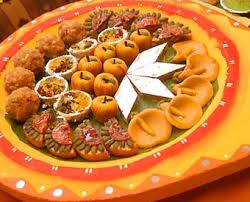 The celebration however features various rich savoury and sweet dishes, and while eating out is popular, families will mostly prepare food at home for when guests arrive to exchange gifts and watch fireworks. Unlike the traditional roast turkey at Christmas, each family celebrating Diwali will more than likely have its own favourite meal for the festival, and the food will most often play a central theme to the celebrations.
The celebration however features various rich savoury and sweet dishes, and while eating out is popular, families will mostly prepare food at home for when guests arrive to exchange gifts and watch fireworks. Unlike the traditional roast turkey at Christmas, each family celebrating Diwali will more than likely have its own favourite meal for the festival, and the food will most often play a central theme to the celebrations.
Where can I celebrate Diwali in Dublin
The sixth successive Diwali – Festival of Lights will be celebrated on Saturday 14th of November in the National Arena Tallaght. It is an integrated celebration of victory of good over evil, light over darkness and to bring up the spirit of festivity from diverse community. For more information on Unitas Festival of Lights click here
Details of festival:
Festival ambiance includes entertaining cultural stage show, children activities, spiritual area, Indian cuisine, Asian ethnic bazaar, commercial, promotional shops and spectacular fireworks. – all in one place, in one day..!!
Admission by entry €10 only on early bird offer until 8th Nov. Tickets can be bought online from tickets.ie (online fee €1.50 applies).
Cultural stage show line up includes – Live performance by Jaron Freeman fox – Opposite of everything, Xtraordinary Dancers – breath taking performance, Amazing Indian Bhangara Dance, Bollywood dances, Classical dance and more singing – all themed around Indian wedding & mythology.
The Origin of Diwali
Historically, the origin of Diwali can be traced back to ancient India, when it was probably an important harvest festival. However, there are various legends pointing to the origin of Diwali or ‘Deepawali.’ Some believe it to be the celebration of the marriage of Lakshmi with Lord Vishnu. Whereas in Bengal the festival is dedicated to the worship of Mother Kali, the dark goddess of strength. Lord Ganesha, the elephant-headed God, the symbol of auspiciousness and wisdom, is also worshiped in most Hindu homes on this day. In Jainism, Deepawali has an added significance to the great event of Lord Mahavira attaining the eternal bliss of nirvana.
These Four Days
Each day of Diwali has its own tale, legend and myth to tell.
- The first day of the festival Naraka Chaturdasimarks the vanquishing of the demon Naraka by Lord Krishna and his wife Satyabhama.
- Amavasya, the second day of Deepawali, marks the worship of Lakshmi, the goddess of wealth in her most benevolent mood, fulfilling the wishes of her devotees. Amavasya also tells the story of Lord Vishnu, who in his dwarf incarnation vanquished the tyrant Bali, and banished him to hell. Bali was allowed to return to earth once a year, to light millions of lamps to dispel the darkness and ignorance, and spread the radiance of love and wisdom.
- It is on the third day of Deepawali — Kartika Shudda Padyami that Bali steps out of hell and rules the earth according to the boon given by Lord Vishnu.
- The fourth day is referred to asYama Dvitiya (also called Bhai Dooj) and on this day sisters invite their brothers to their homes.
The Significance of Lights & Firecrackers
All the simple rituals of Diwali have a significance and a story to tell. The illumination of homes with lights and the skies with firecrackers is an expression of obeisance to the heavens for the attainment of health, wealth, knowledge, peace and prosperity. According to one belief, the sound of fire-crackers are an indication of the joy of the people living on earth, making the gods aware of their plentiful state. Still another possible reason has a more scientific basis: the fumes produced by the crackers kill a lot of insects and mosquitoes, found in plenty after the rains.
The Tradition of Gambling
The tradition of gambling on Diwali also has a legend behind it. It is believed that on this day, Goddess Parvati played dice with her husband Lord Shiva, and she decreed that whosoever gambled on Diwali night would prosper throughout the ensuing year. Diwali is associated with wealth and prosperity in many ways, and the festival of ‘Dhanteras’ (‘dhan’ = wealth; ‘teras’ = 13th) is celebrated two days before the festival of lights.
From Darkness Unto Light…
In each legend, myth and story of Deepawali lies the significance of the victory of good over evil; and it is with each Deepawali and the lights that illuminate our homes and hearts, that this simple truth finds new reason and hope. From darkness unto light — the light that empowers us to commit ourselves to good deeds, that which brings us closer to divinity. During Diwali, lights illuminate every corner of India and the scent of incense sticks hangs in the air, mingled with the sounds of fire-crackers, joy, togetherness and hope. Diwali is celebrated around the globe. Outside India, it is more than a Hindu festival, it’s a celebration of South-Asian identities. If you are away from the sights and sounds of Diwali, light a diya, sit quietly, shut your eyes, withdraw the senses, concentrate on this supreme light and illuminate the soul.
The Sikh celebration of the return of the sixth Nanak from detention in the Gwalior Fort coincides with Hindu festival of Diwali. This coincidence has resulted in similarity of celebration amongst Sikhs and Hindus.
The Sikhs celebrate this day as Bandi Chhorh Divas i.e., “the day of release of detainees”, because the sixth Nanak had agreed to his release on the condition that the other fifty-two detainees would also be released. These other fifty-two detainees were the vassal kings who had done something to annoy the emperor.
Emperor Jahangir had imprisoned the sixth Nanak because he was afraid of the Guru’s growing following and power. The Sikhs on this day, which generally falls in october-November, hold a one-day celebrations in the Gurdwaras. So in the evening, illuminations are done with Deewé (earthen oil lamps) or candles and fireworks. The celebrations are held both in the Gurdwaras and in homes.
The story of Divali for the Sikhs is a story of the Sikh struggle for freedom. From the time of Guru Nanak (1469 – 1539), the founder of Sikhism, popular seasonal or folk festivals like the harvest festival of Vaisakhi, or ancient mythological festivals like Holi and Divali, or worship rituals like Aarti, began to take on a new significance for the Guru’s students, the Sikhs. The Guru used these festivals and special days e.g. first day of each lunar month, as symbols or pegs for his teaching themes. And so the Sikhs were slowly diverted from darkness of superstitious ritualism based on fear and ignorance to an enlightened ideology based on reason and belief in One Creator. The enlightened ideology of Guru Nanak gave new significance to ancient festivals like Divali and Vaisakhi
So what about Divali, the festival of lights when, according to Indian lore, Lord Rama returned home after destroying the demon god Ravana who had taken away Rama’s wife, Sita? The story, of course, has no significance in the Sikh tradition. However, in the Sikh struggle for freedom from the oppressive Mughal regime, the festival of Divali did become the second most important day after the Vaisakhi festival in April.
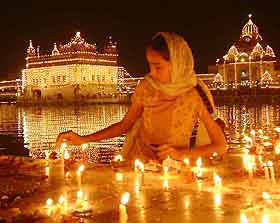 The Sixth Guru Hargobind, was freed from imprisonment in the famous fort of Gwalior by Emperor Jahangir in October, 1619. The reason for the young Guru’s imprisonment was no more than religious bigotry. The Guru’s father, Guru Arjan, had been martyred for the same reason. According to Sikh tradition, the Guru agreed to be freed only if the other Indian chiefs (rajahs) imprisoned with him were freed. Jahangir was under pressure from moderate but influential Muslim religious leaders like Hajrat Mian Mir, a friend of the Guru. So he relented grudgingly and ordained, Let those rajahs be freed who can hold on to the Guru’s coat tails and walk out of prison. He had in mind no more than four or five being freed with the Guru. However, the Guru was not to be outmanoeuvred in this way. He asked for a special coat to be made with 52 coat tails – same number as the rajahs in prison with him! And so the rajahs were freed and the Guru became known popularly as the Bandi Chhor (Deliverer from prison). He arrived at Amritsar on the Divali day and the Har Mandar (now known as the Golden Temple) was lit with hundreds of lamps i.e. he was received in the same way as the Lord Rama and the day came to be known as the Bandi Chhor Divas (the day of freedom).
The Sixth Guru Hargobind, was freed from imprisonment in the famous fort of Gwalior by Emperor Jahangir in October, 1619. The reason for the young Guru’s imprisonment was no more than religious bigotry. The Guru’s father, Guru Arjan, had been martyred for the same reason. According to Sikh tradition, the Guru agreed to be freed only if the other Indian chiefs (rajahs) imprisoned with him were freed. Jahangir was under pressure from moderate but influential Muslim religious leaders like Hajrat Mian Mir, a friend of the Guru. So he relented grudgingly and ordained, Let those rajahs be freed who can hold on to the Guru’s coat tails and walk out of prison. He had in mind no more than four or five being freed with the Guru. However, the Guru was not to be outmanoeuvred in this way. He asked for a special coat to be made with 52 coat tails – same number as the rajahs in prison with him! And so the rajahs were freed and the Guru became known popularly as the Bandi Chhor (Deliverer from prison). He arrived at Amritsar on the Divali day and the Har Mandar (now known as the Golden Temple) was lit with hundreds of lamps i.e. he was received in the same way as the Lord Rama and the day came to be known as the Bandi Chhor Divas (the day of freedom).
Guru Hargobind reached Amritsar on the eve of Diwali, after his release from Gwalior fort, during the reign of Jahangir.The People illuminated the Golden Temple and the city splendidly to celebrate the return of their Guru to the city. Thereafter, Diwali is being celebrated at Amritsar with great pump and show, and also with a lot of religious fervour.
During the fair, religious congregations are held at Manji Sahib, Akal Takhat and Baba Atal which continue for three days. A large number of poets and singers also participate. Recitation of Granth Sahib is done at Darbar Sahib, Akal Takhat and various gurudwaras in the vicinity of Golden Tample.
Early in the morning, pilgrims take a holy dip in the scared tank, while reciting Japji Sahib and thereafter, they go to the Golden Temple for paying their obeisance. They make offerings of various kinds both in cash and kind, such as flowers, candy-drops and parched-rice grains, but mostly the offerings are of karah parshad. which is prepared and sold to the pilgrims by the management. Circumambulation of the tank is considered sacred by the pilgrims.
Illuminations and pyrotechnic display are the unique features of the Diwali celebrations. A mammoth gathering in the parikarma and on the adjoining buildings witness to their great delight the multicolored lights thrown up in the sky and their reflections in the water of the tank. Chain of the electric lights hang along the causeway and on the Darshani Deorhi. Small earthen lamps lighted and fed with sarson oil are arranged in lines all around the tank. All buildings in the compound are bedecked with coloured lights. Candles and small earthen lamps fed with pure ghee are floated in the tank.
This fair is attended by people in the large numbers who come from far and near. A large number of visitors take shelter in the verandahs of the various buildings in the premises. All local inns, rest houses and other common places are packed to capacity. The free mess, called Guru Ram Dass Langar, remains open for all. The whole function is organised by Shiromani Gurudwara Parbhandhak Committee. During the fair, qualified doctors render free medical service to the pilgrims.
Thenceforth, the Sikh struggle for freedom, which intensified in the 18th Century, came to be centred around this day. In addition to the Vaisakhi day (now in April), when Khalsa, the Sikh nation was formally established by the Tenth Guru Gobind Singh, Divali became the second day in the years when the Khalsa met and planned their freedom strategy.
Celebration Of Bandi Chorrh Divas
On the occassion of Bandi Chorrh Divas, Sikhs observe a one-day celebrations in the Gurdwaras. In the evening, illuminations are lighted with Deewé (earthen oil lamps) or candles and fireworks are also bursted. Such celebrations are held both in the Gurdwaras and in homes.
Sacrifice of Bhai Mani Singh on the Occasion of Diwali:
Another important Sikh event associated with Divali is the martyrdom in 1734 of the elderly Sikh scholar and strategist Bhai Mani Singh, the Granthi (priest) of Harmandar Sahib (Golden Temple). He had refused to pay a special tax on a religious meeting of the Khalsa on the Divali day. This and other Sikh martyrdoms gave further momentum to the Khalsa struggle for freedom and eventually success in establishing the Khalsa rule north of Delhi
Bhai Mani Singh was a great scholar and he transcripted the final version of Guru Granth Sahib upon dictation from Guru Govind Singh ji in 1704. He took charge of Harmandir Sahib’s management on 1708. Diwali was not celebrated in Golden Temple at that time. In 1737, he received permission from Mogul emperor of Punjab, Zakaria Khan for celebrating Diwali at Golden Temple for a massive tax of Rs. 5,000 (some authors say it was Rs10,000). Invitations were sent to the Sikhs all over India to join Bandi Chhorh Diwas celebrations at Harmandir Sahib. Bhai Singh thought he would collect the tax-money from the Sikhs as subscriptions who would assemble for the purpose of Diwali Celebrations. But Bhai Mani Singh Ji later discovered the secret plan of Zakariya Khan to kill the Sikhs during the gathering. Bhai Mani Singh Ji immediately sent message to all the Sikhs not to turn up for celebrations. Bhai Mani Singh could not manage to arrange the money to be paid for tax. Zakariya Khan was not happy about the situation and he ordered Bhai Mani Singh’s assassination at Lahore by ruthlessly cutting him limb-by-limb to death. Ever since, the great sacrifice & devotion of martyr Bhai Mani Singh Ji is remembered on the Bandi Chhorh Diwas (Diwali) celebration.

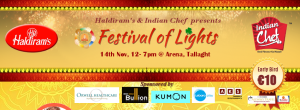

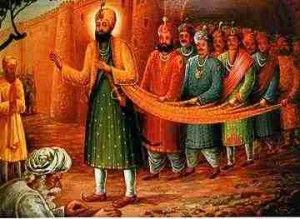
No responses yet